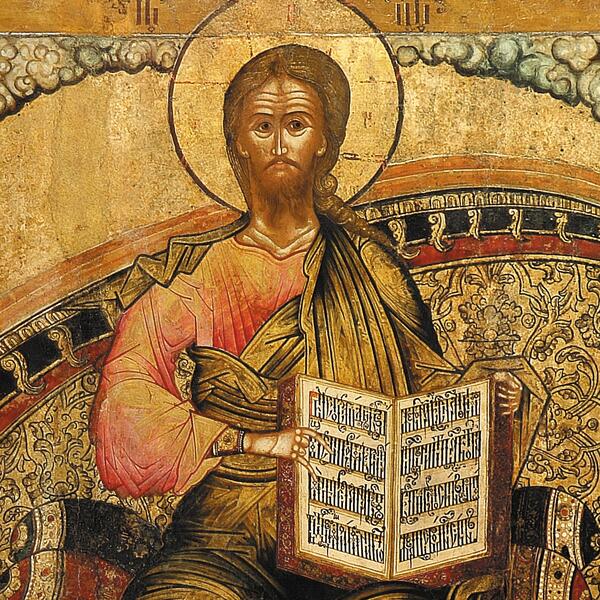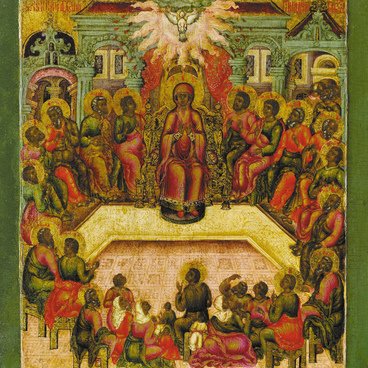The images of Jesus Christ on a throne were widespread in Old Russian art. They originated from the iconographic type of Christ Pantocrator (the Almighty). As the “Ruler of All”, Jesus blesses people with one hand and holds a scroll or the Gospels in the other one. There are full-length, half-length, and chest-length versions of the image.
The word “Almighty” is often used to describe Jesus Christ both in the Old and New Testaments. It represents the idea of the Almighty God being incarnated as the Son of Man, “O Lord Almighty, God of Israel” (Baruch 3:1), “Holy, holy, holy, Lord God Almighty” (Revelation 4:8).
The iconography of this image was established in Byzantine icon painting between the 4th and 6th centuries. In Christian Byzantium, Christ was declared the head of both the church and the state. This is why in the style “Christ Enthroned”, he is depicted as the King of Kings. Facing the viewer and usually surrounded by angels, he sits on a throne with a pillow and a pedestal, wearing the clothes of the Byzantine emperor, and holding the book of the Gospels on his knee. The majority of the pictorial space is occupied by the heavenly throne illuminated with golden beams — the light of the Wisdom of God, the symbol of the royal dignity, and the throne of the Judge where Christ will be seated at the end of time. In the Deesis row, Jesus is flanked by those praying for humanity: the Virgin Mary, John the Baptist, the apostles, venerable, saints, and martyrs. Separate icons of Christ Enthroned usually had between two and four saints standing in front of Jesus.
Versions of this image include “The Savior of Manuel” or “The Savior in a Golden Vestment” (the 11th century). These names refer to the icon’s lost golden setting and the name of the Byzantine Emperor Manuel who wrote “The Tale of the Miraculous Appearance of the Savior’s Icon”. Most likely, “The Savior in a Golden Vestment” was painted for the Saint Sophia Cathedral around 1050.
It differs from other versions in the position of Christ’s right hand: instead of raising it in a blessing gesture, he points at the text of the Gospels with his fingers. This is done to emphasize his role as the Teacher of the Word of God and the Word itself, representing the Second Person in the Holy Trinity. The red edging and the large letters highlight the book as the icon’s center. This image combines the features of various versions including “The Savior in a Golden Vestment”. For example, here, the Savior also points at the text with two fingers. The names of the saints at Christ’s feet are unknown, and the martyr Julitta contributes an additional meaning of the intercession and protection of humanity.
The word “Almighty” is often used to describe Jesus Christ both in the Old and New Testaments. It represents the idea of the Almighty God being incarnated as the Son of Man, “O Lord Almighty, God of Israel” (Baruch 3:1), “Holy, holy, holy, Lord God Almighty” (Revelation 4:8).
The iconography of this image was established in Byzantine icon painting between the 4th and 6th centuries. In Christian Byzantium, Christ was declared the head of both the church and the state. This is why in the style “Christ Enthroned”, he is depicted as the King of Kings. Facing the viewer and usually surrounded by angels, he sits on a throne with a pillow and a pedestal, wearing the clothes of the Byzantine emperor, and holding the book of the Gospels on his knee. The majority of the pictorial space is occupied by the heavenly throne illuminated with golden beams — the light of the Wisdom of God, the symbol of the royal dignity, and the throne of the Judge where Christ will be seated at the end of time. In the Deesis row, Jesus is flanked by those praying for humanity: the Virgin Mary, John the Baptist, the apostles, venerable, saints, and martyrs. Separate icons of Christ Enthroned usually had between two and four saints standing in front of Jesus.
Versions of this image include “The Savior of Manuel” or “The Savior in a Golden Vestment” (the 11th century). These names refer to the icon’s lost golden setting and the name of the Byzantine Emperor Manuel who wrote “The Tale of the Miraculous Appearance of the Savior’s Icon”. Most likely, “The Savior in a Golden Vestment” was painted for the Saint Sophia Cathedral around 1050.
It differs from other versions in the position of Christ’s right hand: instead of raising it in a blessing gesture, he points at the text of the Gospels with his fingers. This is done to emphasize his role as the Teacher of the Word of God and the Word itself, representing the Second Person in the Holy Trinity. The red edging and the large letters highlight the book as the icon’s center. This image combines the features of various versions including “The Savior in a Golden Vestment”. For example, here, the Savior also points at the text with two fingers. The names of the saints at Christ’s feet are unknown, and the martyr Julitta contributes an additional meaning of the intercession and protection of humanity.



